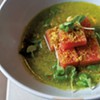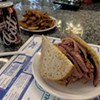Published March 10, 2004 at 5:00 p.m.
First you taste the citrus -- a feature of Latin American cinnamon that sets it apart from the standard stick. Then, mid-tongue, the ancho and chipotle chilis kick in. A cayenne chaser, post-swallow, leaves a satisfying after-burn.
A nuevo Mexican salsa? Nope -- it's a hot new variety of chocolate made by an aspiring Vermont chocolatier. There is nothing Nestle about the way Cheryl Dooley combines unorthodox ingredients in the "exotic artisan" truffles she crafts in her Charlotte home. If her business plan comes together, they could soon make their way to yours.
Curry powder and coconut. Hibiscus. Blood orange and thyme. Pomegranate and fennel. Lemongrass and kaffir lime. Dooley's complex flavor combinations make chocolate consumption an epicurean adventure, more like sipping wine than eating candy.
"I love the wasabi," says Barb Barden, the owner of Let's Pretend catering who often showcases Dooley's Black Flower Chocolate at high-end gigs. "I would never have thought of putting a savory herb in a chocolate, but it works."
Barden likes to hand-pass Dooley's chocolates at events so she can prepare people's palates. And witness their reactions. During a recent Valentine's Day party at Shelburne Farms, "I brought them out and Marshall Webb went crazy for them," she attests. But "you can't just pick them up and start nibbling away. They deserve an explanation."
Dooley, 34, is trying to do with chocolate what other pioneering Vermont food producers have done with coffee, tea, beer and bread: "shift awareness," as she puts it. "My concept of chocolate is more about food than this sugary concoction most people think of." A former personal chef, Dooley views chocolate as a staple, perfectly paired with vinegar, cheese -- even anchovies.
"For thousands of years people were combining chocolate with wine and spices. They'd grind it with corn and maize. It was food, not candy."
Dooley was inspired to marry rosemary and juniper berry in an inch-square chocolate truffle because they go well together with venison. Their piney scent permeates her kitchen on a recent morning -- the result of an earlier "infusion," during which she heated the two ingredients in a saucepan with heavy cream. Mixed with melted chocolate, the emulsion comprises the truffle filling. Five other "ganaches" get similar treatment, to create pink peppercorn, lavender, espresso bean, hazelnut cream and chili pepper varieties.
Dooley checks the "tempering" machine that melts the dark, disc-shaped chips, then clears the bottom shelf in the fridge, where the chocolates will eventually "set up." She is psyched because the day is cloudy -- temperature variations can ruin the chocolate -- and her 4-year-old is in preschool for the morning. Her husband Charley, a producer of high-end craft fairs, is working in a basement office. At last, she can focus.
Dooley used to cut her chocolates by hand until she found molds in Montreal that she liked. She fits a piece of patterned acetate into the bottom of the mold, which looks like an ice cube tray. The colorful designs of edible ink transfer onto what will be the tops of the individual chocolates. Each flavor gets its own look. Dooley writes herself a cheat sheet to keep track of which is which.
What follows is three messy and labor-intensive hours of melting, tempering, filling and chilling truffles. Dooley gets her chocolate from all over the world -- she can taste the difference between Costa Rican, Tanzanian and Venezuelan varieties -- but she won't say how she combines it to get the cacao-rich mix that serves as the "canvas" for her creations.
Dooley fills up the mold with the dark blend and swiftly knocks it out over a bowl, evenly coating the bottoms and sides of the squares. "Willy Wonka," she jokes, deftly wielding a flat finisher to reduce waste. Her movements are speedy and graceful -- a testament to many years in the food business. A graduate of the Natural Gourmet Institute of Food and Health, she once had a business cooking and delivering gourmet meals to clients in New York City.
When her chocolate shells have firmed, Dooley dabs in different ganaches using a pastry bag, which gets a thorough washing between flavors. A final coating of chocolate seals the truffles. When they're cool, Dooley turns them out on the counter: perfect brown squares adorned with tiny gold stars, cosmic blue lines, tiny red fruits. Nestled in a black box that opens origami-style, like a flower, they look like jewels.
Dooley's chocolates don't cost quite as much as rubies and emeralds. A gift box of nine sells for $18 retail. The same number of "gourmet" sweets from Lake Champlain Chocolates runs between $12 and $25. CEO Jim Lampman notes, "Burlington is a terrific market for introducing a high-quality product with a price point well above the mass market."
He should know. Lampman pioneered high-end chocolate in Vermont and he believes there's a niche here for "exotic" flavored chocolate like Dooley's. He remembers launching an Earl Grey truffle some time back. "It bombed." Ditto a Cabernet Sauvignon variety. "They were ahead of their time," Lampman says. The closest thing his company offers is a "small world" collection, featuring mole, mango, lemon ginger, pistachio and chai varieties.
Dooley has no trouble coming up with interesting combinations, but she's having a tougher time landing the basic entrepreneurial necessities: a production facility, retail outlet and start-up cash. She's developed a client base over the past two years through out-of-town craft shows and Barden's local word of mouth, but business cards and an email address are no substitutes for a little shop frequented by well-heeled chocoholics.
Plus, she's got national competition. Although Dooley is the only confectioner in Vermont going the haut-chocolat route, another company, Vosges, has already beaten a path to the exotic chocolate market. The Chicago confectioner recently launched an aboriginal Australian line. Dooley knows chocolates infused with wattleseed and forest berry could be a tough sell -- even on Church Street.
But the cheerful chocolatier is undaunted. She has designs on a production space in Burlington's Flynndog building. She hired veteran local artist Anthony Sini to design custom acetate transfer sheets and packaging materials. And she's well connected. The last time she tried to raise capital for a Vermont food venture -- when she and Charley almost bought the Starry Night Cafe in Ferrisburgh -- she rustled up $180,000.
Dooley is currently sending letters to potential investors. Whether or not they decide Black Flower is a sweet deal, there's no way a single one of them is going to pass up the accompanying box of chocolates.
More By This Author
Speaking of Food, Underlines
-

Q&A: Howard Fisher Delivers Meals on Wheels With a Side of Good Cheer
Dec 20, 2023 -

Video: Howard Fisher Delivers Meals on Wheels
Dec 14, 2023 -

Q&A: Alexis Dexter Rescued 57 Shelter Cats During the July Flood
Sep 13, 2023 -

Video: Two Months After the Flood, Alexis Dexter Rebuilds Kitty Korner Café in Barre and Continues to Rescue Cats
Sep 7, 2023 -

Video: Saying Goodbye to Burlington’s Penny Cluse Café
Nov 17, 2022 - More »
Comments
Comments are closed.
From 2014-2020, Seven Days allowed readers to comment on all stories posted on our website. While we've appreciated the suggestions and insights, right now Seven Days is prioritizing our core mission — producing high-quality, responsible local journalism — over moderating online debates between readers.
To criticize, correct or praise our reporting, please send us a letter to the editor or send us a tip. We’ll check it out and report the results.
Online comments may return when we have better tech tools for managing them. Thanks for reading.














































